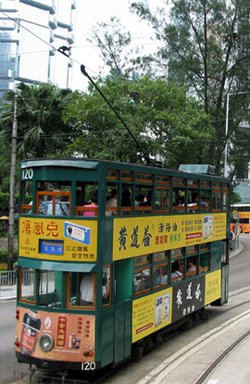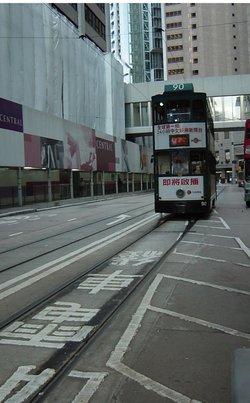Hong Kong Tramways
|
|
Hk_tram_jam.jpg
Hong Kong Tramways (香港電車 Cantonese IPA: ; Mandarin Pinyin: xiang1gang3 dian4che1) is one of the two tramways in the world which provide regular operation of double-decker trams (the other being Blackpool, England), and is the only system run exclusively with double-deckers.
Trams in Hong Kong are not only a form of transport, but they have also become a major tourist attraction.
| Contents |
History
The electric tram system was proposed in 1881; however nobody was willing to invest in a system at the time. In August 1901, the Second Tramway Bill was introduced and passed into law as the 1902 Tramway Ordinance. Hong Kong Tramway Electric Company Limited, a British company, was authorized to take the responsibilities in construction and daily operation. It was soon taken over by another company, Electric Tranction Company of Hong Kong Limited and then the name was changed to Hong Kong Tramways Company Limited in 1910.
In 1922, a new company, Hong Kong Tramway Limited (HKT), was founded to take over and operate the system. The Tramway Ordinance of 1902 had awarded a 25 year operating mandate, which was then extended to a 50-year contract and officially expired on May 23 1952. Due to the extension of the mandate, the Hong Kong Government had the chance to purchase the tramway at 5 year intervals provided always that 6 months notice of such intention is given. In 1974, Hong Kong Tramways became part of the Hong Kong and Kowloon Wharf and Godown Company Ltd. and now operates under the Wharf Transport Investments Ltd.
The Hong Kong Tramways system was built from May 1903 (see #Timeline of Tramways History below). After equipment testing, the electric tram began operation on July 30 1904, making the Hong Kong Tramways one of the oldest public transport systems still in operation. At that time the main route went along the northern waterfront of the Hong Kong Island from Arsenal Street in Causeway Bay to Shau Kei Wan, with a branch serving Happy Valley. Shortly after the line was extended westards to Kennedy Town. The length of the route was 15 km (9.3 miles) as same as that of today, except for track relocations and the extension of the Happy Valley branch in 1914. Originally constructed with both single and double track sections, the last single track section was eliminated in August 1949. The reserved track was introduced along Queensway from 1955.
In the late 1970's and early 1980's, there were fears about the survival of the trams when the Mass Transit Railway began to construct the Island Line, which runs along a route that is similar to the trams' route. A survey was taken by the company in 1984, and the results concluded that the public would prefer to keep the trams system intact.
Operations
TramStop.jpg
|
| Service hours | ||||
| From | Bound | Weekdays | Saturdays | Sundays and general holidays |
| Kenndy Town | east bound | 05:10-23:54 | 05:07-23:57 | 05:12-23:54 |
| Western Market | east bound | 06:00-00:02 | 06:01-00:00 | 06:13-00:00 |
| Happy Valley | east bound | 06:34-23:10 | 06:34-23:10 | 06:34-23:10 |
| west bound | 05:59-00:37 | 06:00-00:40 | 06:04-00:37 | |
| North Point | west bound | 06:07-23:17 | 05:20-23:17 | 06:07-23:17 |
| Shau Kei Wan | west bound | 05:58-23:55 | 05:58-23:36 | 05:56-23:36 |
| average frequency during peak hours: 90 seconds | ||||
| Duration of journey (in minutes) | |||||
| Western Market | Causeway Bay | Happy Valley | North Point | Shau Kei Wan | |
| Kennedy Town | 23 | 55 | 60 | 70 | 80 |
| Western Market | - | 35 | 40 | 50 | 58 |
| Causeway Bay | 40 | - | 5 | 35 | 42 |
| Happy Valley | 35 | 5 | - | 15 | 25 |
| North Point | 50 | 15 | 35 | - | 15 |

Most of the tram stop locations remain unchanged since their establishments. However, some did have their names changed e.g. "Shu Shen Guan" in the 1940s is now named "World-Wide Building". In 1934, Hongkong Tramways introduced loading islands (i.e. waiting areas) at some busy tram stops to ensure safety of passengers. Today, there are 123 tram stops in total. Most of them are sheltered, with a handful of tram stop signs still standing on the sidewalks.
Just like buses, trams in Hong Kong can be very crowded. The maximum capacity of each tramcar is 115 people. During the busier periods of the day, trams often stack up when there are many tramcars running on the railway lines at the same time. In 2002, the trams recorded an average of 240,000 passenger trips daily.
There are seven terminal points at Kenndy Town, Whitty Street, Western Market, Causeway Bay, North Point, Shau Kei Wan and Happy Valley respectively. There are altogether 123 tram stops. Tram stops are densely located in an average interval of 250 metres (820 feet). Most of them are located in the middle of road, connected with pedestrian crossings or footbridges. Major ones include: Yee Wo Street stop at Causeway Bay, Pacific Place stop at Admiralty, and Prince's Building / Landmark stop at Central. Travelling in the lower deck of the tram allows travellers to have a close up view of the local street life, while occupying the front seats of the upper deck gives good views of the town as the tram rattles slowly.
The tram service starts at 05:10 and ends at around 01:00 every day. On average, the interval between each tram is approximately 1.5 minutes in peak hours.
As the trams move slowly, with a maximum speed of about 40 km/h (25 mph), they are comparatively safe. Only a few major accidents have occurred. In fact, according to the Hong Kong Census and Statistics department, up to the end of 2002, less than 10 traffic accidents which involved trams occurred per year on average, meaning that the possibility of a tram being involved in an accident is very low.
Fleet
The Hongkong Tramways Ltd now owns a total of 163 double-decker trams, that makes it the only fully double-decker tram fleet in the world, including two open-balcony trams (#28, 128) for tourists and private hire and one special maintenance tram (#200). Most of the trams in operation now were built in the late 1980s or early 1990s. They are equipped with slide windows. Since the early 2000s, these trams have been upgraded to provide better operating performance and safety.
Air-conditioned_tram.jpg
In 2000, three new modern trams (officially called "Millennium trams"), #168 - #170, started operation. These trams are made of a sturdy alloy aluminum metal body. A prototype air-conditioned tram #171 is now in testing.
The tram fleet was first composed of 26 single-deck trams with bodies 29 feet (8.8 m) long and 6 feet and 1 inch (1.9 m) wide imported from England. However, they were quickly removed because of the rapid modernization programs. These tramcars were replaced by open-top double-deck tramcars from 1912 onwards. The introduction of permanent roofs to all fleets in 1923 was a big improvement on the system. In 1960s, the design of adding a trailer at the back of the double decker trams was proposed due to the increasing population and demands. In December 1964, after testing a prototype built by Taikoo Dockyard in Hong Kong, 10 trailers were ordered from England and were assembled to the trams in Hong Kong in early 1965. Ten additional trailers were ordered from England in 1967, bringing the total number of trailers to 22. The trailers served as the first class of the trams. This type of tram was abdicated at the end of 1982 since the trailers produced so much noise when moving.
Fleet Details
- Manufacturer: HK Tramways
- Rebuilt (1986) - 159
- Millennium tram: 3
- Maintenance car: 1
- Original cars (1904-1912): 26 - from UK
- Second Generation (1912-1918)
- Third Generation (1918-1930s)
- Fourth Generation (2000) - alloy aluminum
- Current cars (1930s-1964): 166
- Single deck cars (1964-1982)
Depot
North Point Depot and Sharp Street Depot
With the upsurge in the number of trams, the original depot was too crowded in 1932. Hongkong Tramways then got hold of the North Point Depot site at King's Road for trams' parking purposes. In 1951, the North Point Depot was closed and the construction for a single comprehensive depot at Russell Street in Causeway Bay to house the whole tram fleet was started. Upon its completion, the depot was renamed as the Sharp Street Depot. To give way to the redevelopment of the area, the Sharp Street Depot was closed in 1989 and split into 2 depots, the present Sai Wan Ho depot (East Depot) and the Whitty Street depot (West Depot). The old sharp street tram depot was dismantled and the existing very popular commercial complex, Times Square was then constructed.
Arsenal Street Depot
Whitty Street Depot
Sai Wan Ho Depot
Costs
Fares on the trams are, by local standards, low. The fare is HK$2 for adults, and HK$1 for children under 12 and senior citizens aged 65 or above. Unlike other forms of public transport in Hong Kong (such as the Mass Transit Railway), the fares are fixed regardless of the distance travelled. Payment using coins or Octopus card is made upon alighting from a tram, by depositing the exact fare (no change can be given) or swiping the card at the box next to the driver.
Ordinary and antique trams are also available for private hire [1] (http://www.hktramways.com/en/advert/index_tramhire.html). The open-balcony antique trams are especially welcomed by people holding parties or promotional events. Tourists can also travel the open-balcony trams through the tours organized by the Hong Kong Tourism Board.
Timeline of Tramways History
- 1881 : Idea of Tramways System was proposed in Hong Kong
- 1901 : The proposal was accepted by Hong Kong Government
- 1902 : Hong Kong Tramway Electric Company Ltd was founded, and the name was changed by the end of this year to Electric Tranction Company of Hong Kong Ltd
- 1903 : Tramways engineering development started
- 1904 : Track connecting Wan Chai, Happy Valley and Shau Kei Wan were completed
- 1910 : Name of the company was again changed to "The Hongkong Tramways Ltd"
- 1912 : Double-decker trams were introduced
- 1922 : Electricity was contracted and supplied by Hongkong Electric Co. Ltd (HEC)
- 1932 : The North Point Depot went into service
- 1949 : Double-railway system was adopted, and radical renewal was started
- 1954 : The North Point Depot was closed and the Russell street one was expanded and renamed as the Sharp Street Depot
- 1964 : Three local-made train-carriage were added
- 1967 : New type train-carriage was designed
- 1974 : The Hongkong Tramways Ltd was owned by Wharf (holding) Limited
- 1979 : Last tram was manufactured
- 1982 : All tram-carriages were mustered out
- 1986 : Another renewal
- 1989 : The old Sharp Street Depot was closed and split into the Sai Wan Ho and the Whitty Street depots
- 2000 : New generation trams (Millennium trams) were introduced
See also
External links
- Hong Kong Tramways (http://www.hktramways.com)
- History of Trams - HK Tramways (http://www.geocities.com/Tokyo/Bay/9585/index.html)de:Hong Kong Tramways



